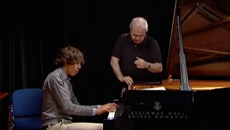Review: Emanuel Ax Weathers Beethoven’s Emotional Storms at Carnegie Hall
By admin on October 20, 2016 | Category: News | No CommentsBy
The New York Times
28 April 2016
Describing a pianist’s performance as unhinged might seem like an unlikely compliment. But the adjective could be applied in the most flattering terms to Emanuel Ax’s engrossing interpretation of Beethoven’s “Pathétique”Sonata on Wednesday evening at Carnegie Hall.
The sonata was included on an all-Beethoven lineup, with two popular sonatas bookending three lesser-known pieces. Mr. Ax brought demonic power to the “Pathétique,” which opened the program. In the opening section, he revealed with particularly vivid colors the contrast between crashing low chords and the yearning melody in the upper register. His clarity of line was admirable in the tumultuous thickets of the first movement; the ethereal Adagio unfolded with a gorgeous simplicity; and he imbued the third-movement Rondo with seething tension.
After the tumult of the “Pathétique,” Mr. Ax offered a lighthearted contrast, a delightful and delicately shaded interpretation of the Six Variations on an Original Theme in F (Op. 34). Beethoven wrote the “Pathétique” during what historians have recognized as his early period, when he was already challenging the precedent of Viennese Classicism established by composers like Mozart and Haydn. He continued to break new ground in his middle period, when he composed the “Appassionata” Sonata. Mr. Ax brought passion and power in admirable measure to his performance, which concluded the program on a stormy note.
Beethoven’s Sonata No. 16 in G is perhaps the least often programmed work of his Opus 31 set, which includes the famous “Tempest” Sonata. It received an insightful and elegant performance here. Mr. Ax played the runs in the first movement with sparkling energy; the trills of the Adagio unfolded with leisurely grace, and the concluding Rondo with both strength and charm.
The second half of the program included an unfamiliar short bonbon: thePolonaise in C (Op. 89), which Beethoven wrote in 1814 for festivities at theCongress of Vienna and dedicated to a visiting czarina. After all the dramatic Beethovenian moods, Mr. Ax offered a gentle encore: an introverted rendition of Schubert’s “Der Müller und der Bach,” in Liszt’s transcription.

